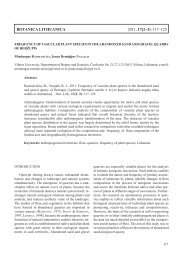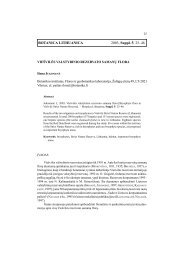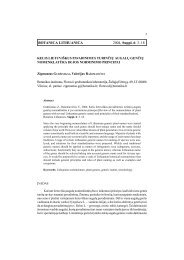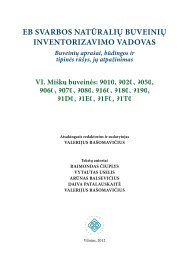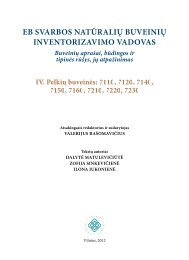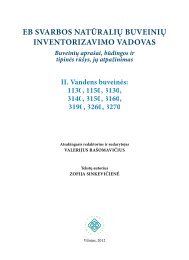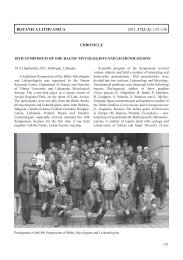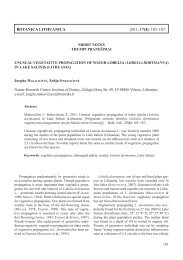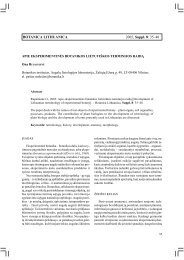FUNGI AND LICHENS IN THE BALTICS AND BEYOND XVIII ...
FUNGI AND LICHENS IN THE BALTICS AND BEYOND XVIII ...
FUNGI AND LICHENS IN THE BALTICS AND BEYOND XVIII ...
Create successful ePaper yourself
Turn your PDF publications into a flip-book with our unique Google optimized e-Paper software.
DIRECT AMPLIFICATION OF FUNGAL DNA FROM VARIOUS SAMPLES<br />
A. KAČERGIUS<br />
Institute of Botany, Nature Research Center, Žaliųjų ežerų Str. 49, LT-08406, Vilnius,<br />
Lithuania<br />
E-mail: audrius.kacergius@botanika.lt<br />
Thermo Scientific Phire Plant Direct PCR Kit enables DNA amplification directly<br />
from various plant tissues, including fungal samples: mycorrhiza, diseased plant parts and<br />
axenic cultures. Such procedure saves both time and costs. The simple protocol for target<br />
fungal DNA amplification without primary DNA purification is presented. The Phire Plant<br />
Direct PCR Kit contains reagents and tools for two alternative methods: direct and dilution<br />
protocols. Dilution protocol is also suitable for storing the DNA samples for short periods at<br />
+4°C, and for long-time storage at -20 °C. The kit employs Phire Hot Start II DNA<br />
Polymerase, a specially engineered enzyme that exhibits extremely high resistance to many<br />
PCR inhibitors found in plants and fungi. We applied the method for mycorrhizal fungi,<br />
amplifying part of rRNR gene, as well as phytopathogenic fungi from axenic cultures and<br />
directly from diseased plants. Suitable amplicons were sequenced after conventional<br />
EXO/SAP purification, manually editing ambiguous readings, and queried in sequence<br />
database at NCBI using blastn algorithm. These protocols were employed for identification of<br />
mycorrhizae in the project “Changes in biotic and abiotic ecosystem components induced by<br />
an invasive species: case study of the great cormorant”, funded by a grant (No. LEK-23/2010)<br />
from the Research Council of Lithuania.<br />
PHYLOGENETIC ANALYSIS OF Phomopsis ISOLATES FROM DIFFERENT<br />
HOST PLANTS<br />
A. KAČERGIUS 1 , R. RODEVA 2 , J. GABLER 3 , Z. STOYANOVA 2<br />
1 Institute of Botany, Nature Research Center, Žaliųjų Ežerų Str. 49, LT-08406, Vilnius,<br />
Lithuania<br />
2 Institute of Plant Physiology and Genetics of BAS, 1113 Sofia, Bulgaria<br />
3<br />
Institute for Epidemiology and Pathogen Diagnostics of the Julius Kühn-Institute (JKI) –<br />
Federal Research Centre of Cultivated Plants, D-06484 Quedlinburg, Germany<br />
E-mails: audrius.kacergius@botanika.lt, r.rodeva@abv.bg, jutta.gabler@jki.bund.de<br />
Phomopsis is a large genus of plant-inhabiting Coelomycetes fungi distributed<br />
worldwide. Phomopsis is the only known anamorph of Diaporthe. Fungi in the genus<br />
Phomopsis and its sexual state Diaporthe cause serious diseases on a wide variety of hosts.<br />
Lately new emerging plant diseases caused by Phomopsis spp. have been established on<br />
various hosts in Bulgaria, Germany and Lithuania. So far their identification to the species<br />
level was unsatisfying because of the insufficient morphological and cultural characteristics.<br />
Phylogenetic analysis was performed on 76 isolates of Phomopsis using sequences from the<br />
Internal Transcribed Spacers 1 and 2, including 5.8S region of the nuclear ribosomal DNA. In<br />
this study we used NCBI database, CLUSTALW and DNASTAR Lasergene 8.1.4 softwares.<br />
The results from phylogenetic trees indicated, that some non-identified to species level<br />
isolates had very close relationships to Diaporthe angelicae (97–99 %) and to Phomopsis<br />
diachenii (98–99 %). Bootstrap analysis showed strongly defined clade (99 %) of Phomopsis<br />
isolates from Lactuca sativa. The results of present study confirm previous observations that



